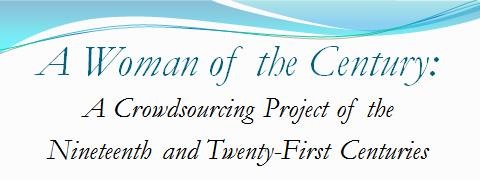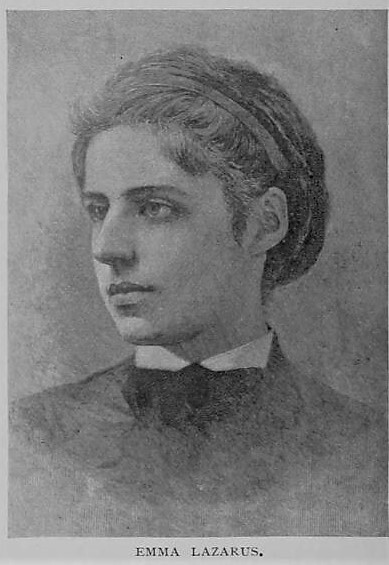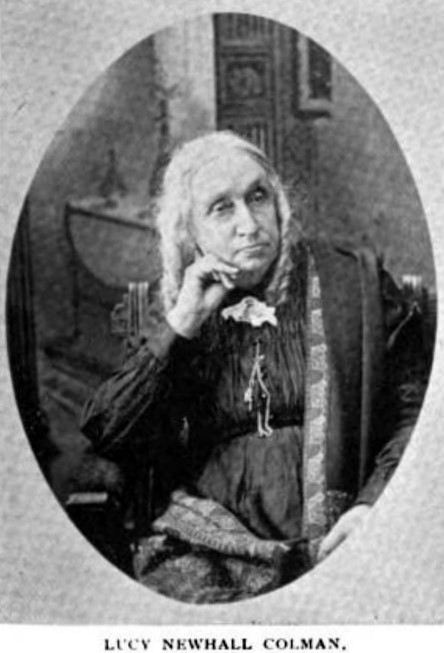July 21 - July 27
Women of the Week
Author Emma Lazarus, who was born on July 22, 1849, and Anti-slavery agitator and woman suffragist Lucy Newhall Colman, who was born on July 26, 1817, are this week's Women of the Week.
-
To learn about them by viewing their items, please click on their images.
-
To read their biographical sketches in A Woman of the Century, please click on the highlighted page number[s] to the left of their images.
Emma Lazarus was born in New York, New York on July 22, 1849 and died there on November 19, 1887.
Emma was inspired and mentored by Ralph Waldo Emerson. In 1868, she mailed her book to Ralph Waldo Emerson which resulted in a mentor-mentee relationship. For a few years, Emma asked him for feedback on her poems, and Emerson gladly provided critiques and praise. A rift occurred in their relationship in 1873, as Ralph Waldo Emerson did not publish her work in his anthology, Parnassus. Emma never found out why he did not her print her work, since he never responded to her letters.
Miss Lazarus volunteered at the Hebrew Immigrant Aid Society (HIAS) after visiting Russian Jewish Immigrants living in squalor at Ward Island. These immigrants had left Russia due to the Czar’s ongoing pogroms and other antisemitic acts. The HIAS, which was formed in 1881, provided meals, transportation, and employment counseling.
That same year, Emma wrote several poems for a broad range of audiences concerning the antisemitism occurring in Eastern Europe, particularly Russia. Her poems, "The Banner of the Jew," "The Exile," and "The Death of Death" (she dedicated this to "George Eliot," for her inspiration and dream of a Jewish nation), portrayed the tragic suffering and degradation of her people (Jews). Emma was an early proponent of what became the Zionist movement. Her views are illustrated in her “Epistle for Hebrews."
Emma wrote"The New Colossus," a sonnet, in 1883 as part of fundraiser for the Statue of Liberty's pedestal. She wanted others to know that this poem voiced support for the immigrants coming to the shores of New York City. Unfortunately, Emma did not live to see the fruit of her labor. It was 1886 by the time sufficient money was raised to erect the statue in New York Harbor, and Emma passed in November of 1887, before its completion. To honor Miss Lazarus's work, her friend, Georgina Schuyler, had Emma's poem engraved on a plaque which was mounted on the statue's pedestal.
Her volunteer efforts and ideas also led to the creation of the Hebrew Technical Institute, which was formed in 1884 in New York City. This non-sectarian facility provided training in vocational skills for students ages 14-17. Later, it became known as the first technical high school in America.
In 1944, The Emma Lazarus Federation of Women’s Clubs was founded by the Women’s Division of the Jewish People’s Fraternal Order of the International Workers Order. Its mission was three-fold: to provide relief to wartime victims, to combat racism and antisemitism, and to foster Jewish identification through its educational programs and women’s rights.
To honor Miss Lazarus's accomplishments as a famous poet, Ruth Hollander, a senior from Tucson High School, was elected president of the newly formed Emma Lazarus B'nai B'rith Women’s Group in March, 1951.
Lucy Newhall Colman, an anti-slavery agitator and woman suffragist, was born in Sturbridge, Massachusetts on July 26, 1817. She married at eighteen and moved to Boston, but her husband died of consumption in 1841.
She married again two years later and gave birth to a daughter in 1845. Colman began to advocate for equal rights of women and emancipation of the slaves in 1846. In her anti-slavery work, Lucy was associated with William Lloyd Garrison, Wendell Phillips, and Frederick Douglass.
When Mr. Colman, an engineer on the New York Central Railroad, was killed in a railroad accident in 1852, Andrew Jackson Davis presided at his funeral in Rochester, NY. While living in Rochester, Lucy took over the “colored school” to close it, encouraging parents to send their children to district schools.
Lucy lectured in several states about the causes she believed in. In 1857, the Anti-Slavery Bugle of New-Lisbon, Ohio published her recollections of her travels on behalf of the cause. During the Civil War, the well-connected Lucy Colman arranged and attended a meeting at the White House between Sojourner Truth and President Lincoln.
Susan B. Anthony invited Lucy to read a paper at a state convention of teachers, and Mrs. Colman chose to use this opportunity to advocate for the abolition of corporal punishment in the Rochester schools.
Later, Lucy served as matron in the National Colored Orphan Asylum in Washington, D.C. and was appointed teacher of a ”colored school” in Georgetown, D.C.
Lucy wrote about her life in Reminiscences, which was published by H. L. Green in 1891. She passed away in Syracuse, New York on January 18, 1906.


